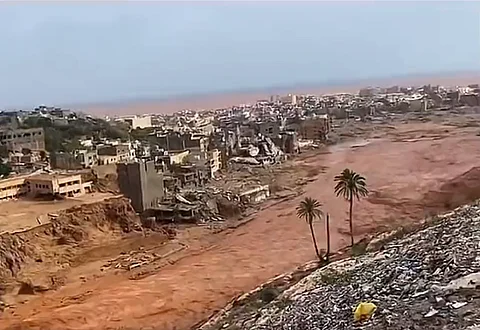

Extreme rainfall, exacerbated by climate change and aging infrastructure were key factors behind the catastrophic flood disaster in Derna, Libya, in September 2023, a new study has revealed.
The research, conducted by the United Nations University Institute for Water, Environment and Health (UNU-INWEH) and published in the journal Natural Hazards, highlighted the vulnerability of Libya’s infrastructure to extreme weather events.
In the northeastern city of Derna, Storm Daniel, which exhibited characteristics of tropical cyclones, triggered a record-breaking precipitation event on September 10, 2023, with up to 400 millimetres of rainfall in just 24 hours. The unprecedented deluge caused the collapse of two embankment dams — the 75-metre-high Bu Mansour dam and the 40-metre-high Elbilad dam — resulting in devastating floods.
The disaster led to the deaths of over 11,000 people and caused extensive damage to more than 8,500 buildings. Both failed dams were over 50 years old and had long suffered from significant structural weaknesses and inadequate maintenance.
Using advanced satellite imaging techniques, researchers analysed structural vulnerabilities in the dams between 2016 and 2023. They found signs of differential settlement, a phenomenon where parts of a structure’s foundation sink at varying rates. The Bu Mansour and Elbilad dams exhibited an uneven sinking rate of approximately 1.8 mm per year, indicating progressive structural instability.
The study also examined the role of climate change in intensifying the disaster. Researchers found that extreme rainfall overwhelmed Libya’s aging infrastructure, while ongoing political instability hindered necessary maintenance and retrofitting efforts. The lack of consistent governance has contributed to the deterioration of critical infrastructure, making the country more susceptible to such disasters.
In recent decades, human settlements have expanded into floodplains and flood-prone areas worldwide. The study assessed the extent of building damage in Derna as an indicator of human and economic loss.
More than 8,570 buildings were severely affected, with the worst-hit areas located in the Wadi Derna River valley—home to the old city—where post-disaster satellite imagery revealed significant destruction. The research underscored the consequences of poorly planned urbanisation and unchecked expansion into high-risk zones.
The findings highlighted the urgent need for a holistic approach to disaster risk reduction, including regular infrastructure maintenance, political stability and community engagement. Community involvement in risk assessment, early warning dissemination and emergency response planning can significantly enhance resilience and preparedness.
The study underscored the importance of proactive disaster risk management, advocating for improved infrastructure monitoring, the implementation of early warning systems and the development of community resilience programmes to mitigate future risks.